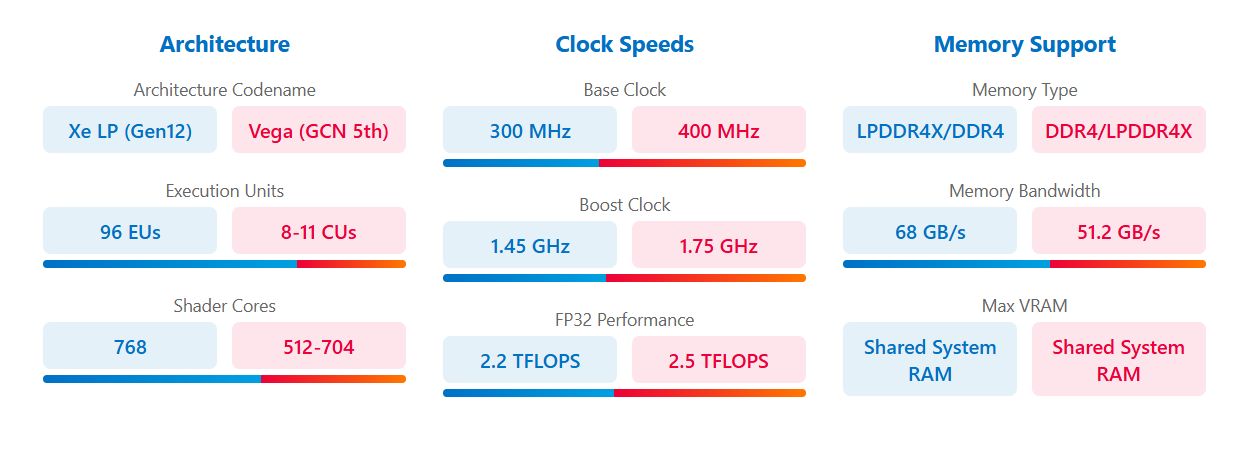Integrated graphics have come a long way, evolving from basic display adapters to capable solutions for gaming, content creation, and productivity. Two of the most prominent players in this space are Intel Iris Xe and AMD Radeon Vega. But which one is better for your needs?
In this in-depth comparison, we’ll examine their architectures, gaming performance, power efficiency, and real-world usability to help you decide whether Intel’s Iris Xe or AMD’s Vega graphics are the right choice for your next laptop or budget PC.
EU (Execution Units): 80 or 96 (G7 models)
Clock Speed: Up to 1.35 GHz (Boost)
Memory Support: LPDDR4X / DDR4 (Dependent on system RAM)
Process Node: 10nm (Tiger Lake) / 7nm (Meteor Lake)
Key Features:
Xe LP (Low Power) architecture
Supports AV1 decode and Quick Sync for faster video encoding
Better driver optimization for DX12 and Vulkan
Intel’s Iris Xe represents a significant leap over its predecessor, Iris Plus, with 84% higher FP32 performance and improved efficiency. The 96EU variant (found in Core i7-1165G7 and Ultra 7 155H) competes closely with entry-level discrete GPUs like the GTX 750 Ti.
CU (Compute Units): 7, 8, or 10 (Vega 7 = 448 cores, Vega 8 = 512 cores)
Clock Speed: Up to 1.8 GHz (Boost)
Memory Support: DDR4 / LPDDR4 (Dependent on system RAM)
Process Node: 7nm (Zen 2/3 APUs)
Key Features:
Based on AMD’s GCN 5.0 architecture
Better raw compute performance than Intel’s Xe in some workloads
Stronger in OpenCL and older DX11 titles
AMD’s Vega iGPUs, particularly Vega 7 (in Ryzen 7 4800H/HS), have been praised for their gaming performance, often surpassing Intel’s Iris Xe in titles like Dota 2 and PUBG. However, Intel’s encoding and streaming efficiency gives it an edge in productivity tasks.

|
Game |
Intel Iris Xe (96EU) |
AMD Vega 7 (Ryzen 7 4800H) |
|
Dota 2 |
54 FPS |
74 FPS |
|
PUBG |
27 FPS |
39 FPS |
|
The Witcher 3 |
21 FPS |
29 FPS |
|
Cyberpunk 2077 |
14 FPS (Low) |
18 FPS (Low) |
Verdict: AMD’s Vega 7 generally leads in gaming performance, particularly in eSports and older AAA titles. However, Intel’s Iris Xe has better driver stability in newer DX12/Vulkan games.
Higher FP32 Compute: Vega’s architecture is more suited for raw compute tasks.
Memory Bandwidth: AMD’s Infinity Cache (in newer APUs) helps mitigate shared memory bottlenecks.
Game Optimization: Many older games were optimized for AMD’s GCN architecture, giving Vega an advantage.
However, Intel Iris Xe has caught up in modern APIs (DX12, Vulkan) and offers better power efficiency in thin-and-light laptops.
Intel Iris Xe:
Quick Sync accelerates H.264/H.265 encoding, making it faster in Premiere Pro and OBS streaming.
Supports AV1 decode, useful for future-proof media playback.
AMD Vega:
Better in OpenCL workloads (Blender, DaVinci Resolve).
Lacks hardware encoding advantage but performs well in multi-threaded rendering.
Verdict: If you prioritize streaming or video editing, Intel’s Quick Sync makes Iris Xe the better choice. For 3D rendering, Vega can sometimes pull ahead.
Intel Iris Xe: More power-efficient in light workloads, extending battery life in ultrabooks.
AMD Vega: Stronger in multi-core CPU-bound tasks (thanks to Ryzen’s superior CPU performance).
Intel Iris Xe (28W TDP) is optimized for thin-and-light laptops, offering better performance-per-watt.
AMD Vega 7 (15-25W TDP) can draw more power under load, but Ryzen APUs balance CPU+GPU efficiency well.
Real-World Impact
Intel-based laptops (e.g., Dell XPS 13) tend to have longer battery life in office tasks.
AMD laptops (e.g., ASUS ROG Zephyrus G14) offer better sustained performance in gaming and creative workloads.
Intel Iris Xe:
Better driver support for Windows and Linux.
XeSS (AI upscaling) is gaining traction in newer games.
AMD Vega:
Still widely supported but lacks AI upscaling (FSR works on Vega but is less effective than XeSS).
More consistent performance in older titles.
✅ Need better video encoding (streaming, editing)
✅ Want longer battery life in ultrabooks
✅ Prefer better driver stability in newer games
✅ Prioritize gaming performance (especially eSports)
✅ Use OpenCL-accelerated apps (Blender, Resolve)
✅ Want better multi-core CPU performance (Ryzen advantage)
For Gaming: AMD Vega 7/8 (better FPS in most titles).
For Productivity: Intel Iris Xe (better encoding, efficiency).
Both are excellent choices, but your decision should hinge on whether you prioritize gaming or content creation.
Intel’s next-gen Battlemage (Xe2) promises ray tracing support in iGPUs.
AMD’s RDNA 3.5 (in Strix Point APUs) will bring RDNA3 improvements to integrated graphics.
The battle between Intel and AMD in the iGPU space is heating up—stay tuned for even more powerful integrated graphics in the near future!

Click to confirm
Cancel